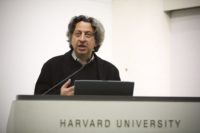Harvard GSD Hires Mostafavi as Dean
The search for a new dean of Harvard’s Graduate School of Design (GSD) came to an end on August 10 with the announcement that the school had nabbed Mohsen Mostafavi, who is currently the dean of the College of Architecture, Art, and Planning at Cornell University, in Ithaca, New York.

Although Mostafavi’s time at Cornell was relatively brief—he arrived in 2004 having previously served as chairman of London’s Architectural Association—he compiled an impressive record of achievements. Pushing forward what had been a beleaguered, twice-stalled plan for an expansion of the college’s building, Mostafavi commissioned Rem Koolhaas’s OMA to design Paul Milstein Hall, as it is now called. He also opened a new satellite space in New York City, providing students with the opportunity to take classes and intern with firms there. Mostafavi inaugurated the school's post-professional Masters of Architecture II degree—which provides a graduate program tailored for students with a bachelor's degree of architecture—recruited several international faculty members, and tripled the amount of money raised by the college each year for its building campaign and other programs.
In January, Mostafavi will head to Harvard. “I am deeply honored to be returning to the GSD,” he says, referring to a five-year stint there during the early 1990s. At Harvard, Mostafavi served as an associate professor of architecture and later the director of its Masters of Architecture I program, which confers graduate degrees to students with backgrounds other than architecture. “Because of its outstanding students, and the remarkable depths within its faculty, the GSD has a scale where you can establish intellectual directions and ask: What is the future of architecture, of urban design, of urban planning, and of landscape architecture?” Stressing his interest in establishing new collaborations with the rest of the university—and outside of the profession—he says that he hopes to redefine and rejuvenate the school’s programs. “It should never be a matter of status quo.”
Mostafavi, who was born in Iran, received a degree in architecture from the Architectural Association in 1976, and later went on to research architecture and urbanism at the University of Essex and at the University of Cambridge. He then taught at various design schools, eventually landing at Cornell.
In addition to running an architectural consulting practice, Mostafavi has written several books, including Surface Architecture (2002), Delayed Space (1994), and On Weathering: The Life of Buildings in Time (1993). Landscape Urbanism: A Manual for the Machinic Landscape, a book he edited in 2003, has become the seminal work in defining an emerging field of practice that combines the often separate practices of landscape architecture, urban design, and architecture.
During the spring 2007 semester at Cornell’s Manhattan campus, Mostafavi taught courses on urban and landscape conditions on the edges of New York City. He hopes to continue developing this field of investigation by looking into a practice he calls “ecological urbanism,” or sustainable design applied at the city-scale. He is also interested in advancing the technological and digital aspects of design.
“There is a lot of attention given to architecture and sustainability, but I would like to explore this at a larger scale by engaging territories and regions instead of single buildings,” he explains. “Our discipline should be an ecological practice, and the GSD should be at the forefront.”
Mostafavi’s career in schools of design, and his training as an architect, should stand him in good stead at the GSD. He replaces Alan Altshuler, who announced his resignation in October but stayed on during the search for a new dean. An expert on planning and policy, Altshuler was said to have faced opposition because he lacked a background in design.




